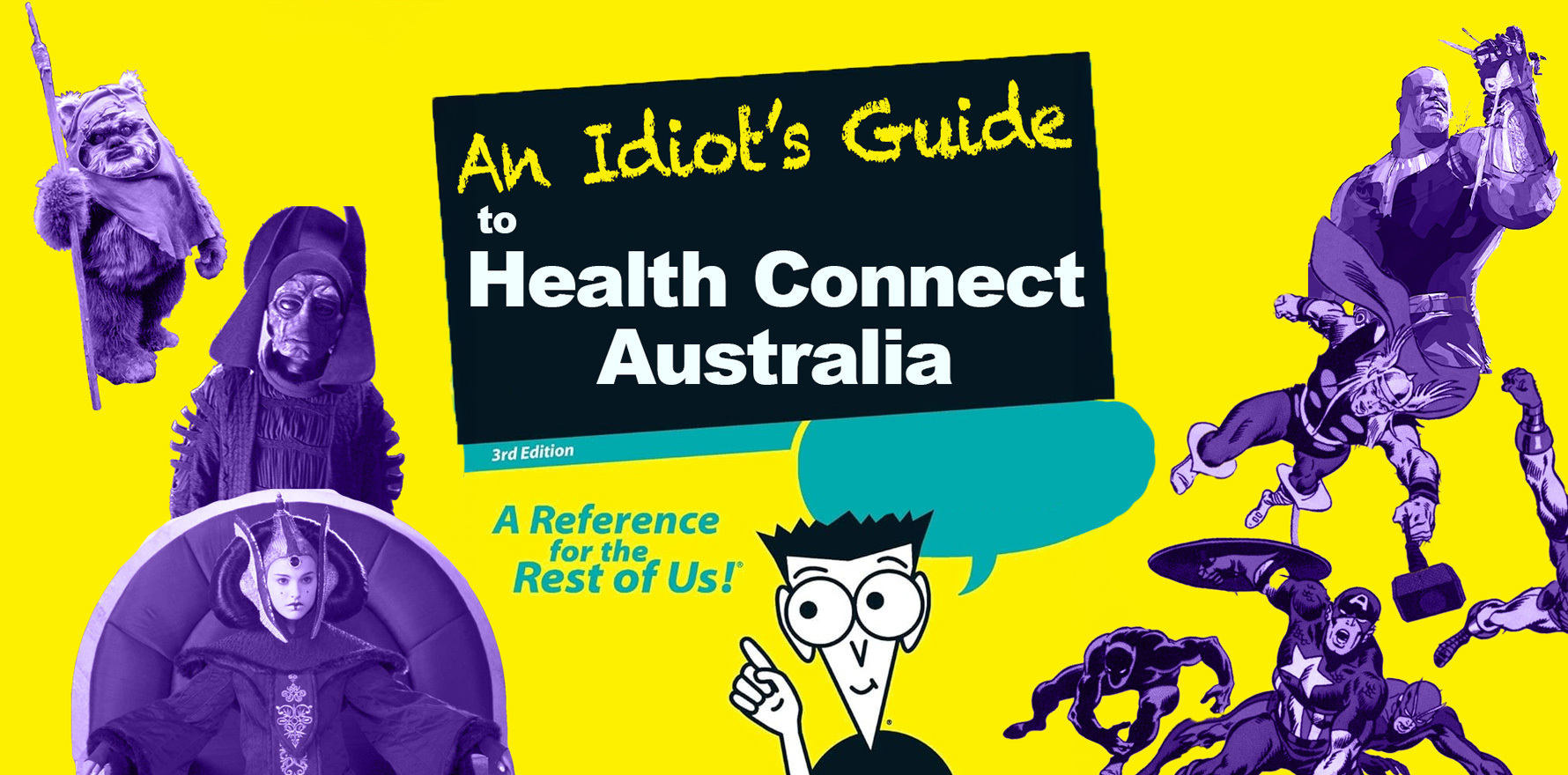Unquestionably the Australian Digital Health Agency has some good plans in play. But I wonder if they could slow down for just a tick and give an idiot like me a 101 guide on how it’s all fitting together.
First, let me say that I’m having one of those weeks. I’m not a great multi-tasker. I run an old model media business and try to grow it somehow – old model media businesses typically don’t grow without a lot of lateral thinking and hard work these days – and simultaneously understand what is going on in the heady world of health services and digital health, and then… write about it when I can.
In a week where the business is facing some natural strategy challenges, and ironically perhaps for this piece, complex technology alignment challenges that relate to strategy, trying to co-ordinate these two completely unrelated skillsets and tasks, is, from a management perspective, terribly inefficient. Hold that thought on two different skill sets and management efficiency for later.
Because I’m mostly on strategy duties this week I was reading Health Services Daily, like any unsuspecting casual reader and I came across what felt like, from the heading, a big new Australian Digital Health Agency (Agency) story – Australia Switches On Nationwide Data Network.
And I was instantly confused by it.
“A major milestone in Australia’s digital health journey has been reached with the nationwide rollout of Health Connect Australia this week,” the story opened with.
The article then announced the release of the Health Connect Australia Strategy subset documents of which include the Health Connect Australia Strategy, the Health Connect Australia Architecture and the Health Connect Australia Roadmap
My confusion was these three new documents landing on top of the major Agency ones I was already aware of, and have read, The National Digital Health Strategy (which also has its own roadmap), The National Healthcare Interoperability Plan, and The HIE Architecture and Roadmap.
When I started reading the HCA Strategy a lot of it felt instantly familiar.
That’s why I’m at least a bit of an idiot.
Health Connect Australia is a new name for the Health Information Exchange (HIE) Architecture and Roadmap project, with apparently some updates from the input of 500 external stakeholders since the last iteration of that document.
Wish someone had said that up front.
I had sat in a talk announcing the change at the Digital Health Festival in early May from Agency CEO Amanda Cattermole, and we had written a story about the change from that and another session from a Department of Health, Disability and Ageing (DOHDA) speaker.
But I’d completely forgotten about it and nowhere in the press release (or our story I’ll admit) was the simple link between the HCA and the HIE made.
I remember the term HCA being mentioned by Agency people a lot since May, but I started to get it consistently confused with Provider Connect Australia (PCA), which is a long-known initiative and subset of the HIE initiative.
Based on my state of confusion I rang around for a quick vox pop of senior and junior digital health burgers who need to understand this stuff for their day-to-day work and everyone was on a spectrum of confused from just a little bit to a quite a lot.
I then rang the person in the Agency who knows all this stuff inside out and he was very clear and gave me a pretty good explanation of the hierarchy of what was actually going on. He may have even been a little miffed that I had to ring him for something, which to him at least, must have felt entirely obvious.
After 30 years or so of 360-degree feedback management assessments in big corporations I know my absolute worst management flaw. I get so immersed in some projects that I begin to assume everyone around me knows and understands what I do. Then I confuse the bejesus out of my staff and proceed to get frustrated that they aren’t, in effect, mind readers.
Digital health transformation might be just about one of the most complex and confusing transformations our government is ever going to attempt, so lots of plans isn’t actually a bad thing.
But frankly there are just so many different initiatives, strategies, related documents and annexures, many of which have names that sound the same and some which have names that even sound the same as external agencies or initiatives connected to the whole thing – Healthdirect vs Health Connect for example.
Its dense and confusing at times.
I’m going to say it’s not that well marketed or communicated either.
I guess they are eager and going pretty fast at this stage.
But if you think about how many stakeholders need to align here it probably is important to slow down a little and make things a bit clearer as you go.
Once I’d rung my Agency contact, I quickly sat down and put it all down on an A4 piece of paper as a flow chart so I could remember the order of things and reference and adapt it for staff as we go along trying to report on the progress of this big change.
Then I sent it to our designer and asked her if she could jazz it up a bit for us all in the clever creative way she does.
To give you a sense of the problem I was trying to solve myself and for staff – some starting just in the past few weeks – see if you can quickly join the dots on the following initiatives and plans that are in some way relative to this week’s announcement about Health Connect Australia: Provider Connect Australia, the Provider Connect Australia Directory, the National Health Services Directory, Healthdirect, the National Health Information exchange, the Council for Connected Care, the National Digital Health Strategy, the National Healthcare Interoperability Plan, the Conformance Framework for National Digital Health Systems, …I’m going to pause here because if you haven’t stopped reading, gone to sleep or become cross eyed, you must at least be getting a bit agitated trying to keep all this stuff in your head.
I have about 20 other related elements to add if you’re in the least bit interested.
When the visual came back from our designer she’d set it up with a multiverse theme.
Cool. I could work with that.
I then wrote some notes to our new piece of office wall art, as labels and arrows aren’t quite enough to get you there if you really want to understand what is going on better and quickly.
If you think it might help you, we’ve created a high-resolution poster size version for you which you can download.
Send us any suggested edits, additions, obvious errors etc if you like.
Australia’s Digital Health Transformation Multiverse.
A multiverse is a hypothetical set of all universes, which can include, but not be limited to “parallel universes,” “alternate universes,” “many worlds,” and “other universes” … which seems to entirely fit our problem here if you think about all the interacting and, at times, weird and competing stakeholders in our digital health transformation problem.
I’m sure some readers might be thinking at this point I’ve started operating in an “alternate universe”. So you can see the metaphor is already working.
The Department of Health, Disability and Ageing (DoHDA)
Is there a master of our digital health multiverse?
Unfortunately not. A federated health system isn’t helping. But between the ADHA, the DoDHA and the collective will of all the state and territory departments of Health we are nominating the DoHDA as “most” in charge.
Just in case anyone’s mind immediately jumped to Thanos (see HERE if you’re confused) in our multiverse analogy, that’s not the DoHDA’s style.
Notwithstanding, it’s perhaps sobering to think that the idea of randomly turning half of the digital health community into dust and seeing what happens next wasn’t that far departed from what the opposition seemed to have in mind early on in the federal election for our Canberra-based digital health crew, and is pretty much precisely what happened when the government last changed in New Zealand. Sidenote: it’s not working too well for New Zealand.
The DoHDA has been doing a lot of research and thinking in the past few years and feeding the Agency a lot of these ideas and plans. Much of this work seems to form the basis for a lot of the planning output from the Agency which collectively might be described as our master plan so far.
The DOHDA also has the unenviable task of negotiating with every state and territory to get them to work in some sort of alignment with this master plan and a parade of other hard to wrangle stakeholders such as the software vendors.
There’s tension here. It’s like the Republic in Star Wars trying to manage the unruly and sometimes rebel infested outer planetary systems.
Related
Federal Government
Our federal government is charged with listening to the DoHDA (and the department is charged with convincing government to go along with Agency and DoHDA ideas) and getting legislation across the line which will support the master plan when there are regulatory or state-based legal or constitutional roadblocks.
The legislation we have seen so far is the Modernising My Health Record – Sharing by Default Act 2024.
But there’s a lot more to come when the DoHDA identifies the time is right. At least that’s what we are being told.
Timing of the legislation is crucial to a lot of stuff that is meant to be built and executed by the Agency as key infrastructure and includes unifying messy state by state consent and privacy legislation; reorganising law around health identifiers to smooth the way on things like real time directory type access to providers and patients in a system; cybersecurity standards; and of course, the big one: mandating FHIR and other relevant technology protocols and standards, so that all software vendors are bound to equalise on more modern cloud sharing technology. This should then create the potential for the development of near real time data sharing between healthcare providers and providers and their patients.
The Agency
The only thing close to a Marvel or Star Wars multiverse analogy we could think of for the Agency – but we’re a bit reluctant to say it for reasons we hope are obvious – is “The Avengers”.
The reason is that in the Marvel multiverse, The Avengers are the people who get things done, and if you’re looking for some unit that is mostly charged in this transformation with doing and building new stuff, it is currently the ADHA.
After that there’s not a lot in the Avengers analogy that seems to be familiar. Tony Stark for instance is way too disorganised to be an Amanda Cattermole.
It’s probably important to note that the Agency is not government and the DoHDA isn’t its boss. It is a quasi-government agency (Commonwealth incorporated) that reports to all state governments and the commonwealth. This is either a good thing or a bad thing. Good because it’s reporting to everyone that counts and everyone has input; bad because it’s reporting to everyone and everyone has input.
The DoHDA has to deal with all that.
Someone once commented to me that the DoHDA are the research and ideas people, and the Agency are the organisers and the doers.
The Agency has done important pre-work if you want to do stuff – plans and organisation – even if they aren’t always communicating it that effectively to us stakeholders.
Now what about all that superhero doing stuff? After all superhero’s main role in life is to get shit done for the greater good right?
The Agency can organise, but can it do?
Is the Agency, which in the past five years has done a pretty good job of turning a fairly dysfunctional My Health Record centre of gravity ship around, and set it a new course, able to navigate the ship to all the goals it has laid out for us in its many plans?
Can it execute its grand plans?
That’s a whole other op ed for another day.
But let’s just say if you look at the history of the organisation and its set up, and the degree of difficulty in some of the infrastructure projects they are suggesting they will either get done themselves (they have a tender out to look at doing a lot in house) or oversee, we have a lot more to think about here.
While the Agency has done a good job under Ms Cattermole laying out a new and sensible roadmap, and aligning stakeholders, building major digital infrastructure is a very complex and different management game.
The Agency hasn’t really built anything of substance in the past five years, with the possible exception of the electronic prescription exchange, although you can argue that this was mainly built by the private sector with Agency guidance and funding and with the unusual collegiate dynamic of covid in play.
Prior to this, the Agency ‘s greatest project was the design and build of the My Health Record. Gong.
The states
The states and territories can take or leave what’s on offer from the DoHDA and the Agency, thanks to federation, but these days things are tough and money scarce in the outer realms of our health multiverse. Anything on offer that is going to save money and resources tends to make these outer planets want to fall into line a lot more. And as far as digital health programs are concerned, the states are all making the right signals.
The other thing that will help along the way is federal legislation that clears up messy state legislation on things like data privacy and consent.
Healthdirect
In our multiverse analogy Healthdirect is like a parallel universe where a graceful, smart and generally helpful race of sentient beings reside. Healthdirect isn’t government either, but it was set up and funded by state and federal governments to help in the most practical ways it can. It has a similar reporting problem to the Agency. Who’s the real boss?
Originally a national nurse-based triage service that began to lose its way a while back; under new leadership and with the rude shock of covid it found new purpose and lots of new ways to help the national system, mostly as an emerging single digital and phone front door for patient provider service navigation and data collection on patient behaviour for the entire country. That part of what Healthdirect does is now called 1800Medicare. Healthdirect get AI and have a lot of rapidly growing data sets to apply it to with a view to creating a lot of new learnings about how the system can work better.
Healthdirect works very closely with the ADHA. Its CEO conveniently was once a long-term COO of the ADHA and CEO.
Sparked – CSIRO
Maybe Vulcans gets us part way there if we want to extend into Star Trek? Super smart race of nerdy beings working on an extraordinarily complex and the previously unsolvable problem of standardising clinical coding so when we get to making vendors build new platforms that can talk in near real time via the cloud, they are all talking the same clinical language.
Nothing would even be able to get started without this base project. The Vulcan analogy like most in this article isn’t very good. Sparked’s spiritual leader, Kate Ebrill is nothing like Spock except for her IQ and calm demeanour in a crisis. She’s otherwise vibrant, positive, inclusive and funny, which has helped her somehow wrangle nearly every stakeholder within a year to get us some important basics in place for everyone to start doing development work on new software from.
The vendors
The software vendors are all important here as it’s their existing tech and the tech that the government needs them to build which will underpin a whole new multiverse. In a multiverse analogy vendors range from clever interplanetary pirates to your run of the mill interplanetary highly capitalised (global) corporations.
It’s a very hard bunch to wrangle, but the government is going to legislate standards and technology protocols to force them to change if they don’t do it themselves. This has happened in what everyone will recognise in a true parallel universe, the US, and strangely has worked, so we have some roadmaps there to work off.
AI – the Expanse
There’s a great Netflix sci fi series called The Expanse which is about a vastly advanced alien technology (and lifeform) which starts growing and is unstoppable. It will either save mankind or destroy it. That’s sort of where we are for AI in healthcare. It’s going to be big no matter what. Predicting where it goes and how fast is near impossible, but it has to be factored in somehow by all our stakeholders above.
Key business integrations
These include all the many key integrations that providers can work with to make their working days a lot more efficient. Key examples include secure messaging applications, Hotdoc, HealthEngine, Cubiko; and other medical record analytics integrations, Heidi and Lyrebird AI, Consultmed, in and outpatient connectors to patient management systems, and so on for a long while.
Services Australia
You know who these guys are. They are important because they run payments and Medicare as well as other important registration and data things for all our providers like PRODA and IHIs
A glossary of the rest
National Digital Health Strategy (NDHS) –anoverarching five-year plan for digital health transformation from the Agency. Talks to most other sub documents and initiatives. Above PCA and next to Interoperability plan.
Provider Connect Australia (PCA) – a planned single point of update portal for every provider for all business integrations and other key services such as government, PHNs, Hospitals and so on.
PCA Strategy –anoverarching strategy for HIE project, talks to NDHS above.
Provider Connect Australia Directory – is not actually a directory but more a map of live APIs which connect providers to all the relevant business integrations and government so that information entered at the provider will update automatically around the entire health system.
Intergovernmental Agreement on National Digital Health (Here) – state and federal digital health funding agreement.
The National Health Services Directory (NHSD) – is actually a directory and maybe our best one, run by Healthdirect as live source of providers for patients using 1800Medicare. Is a key business integration for the PCA, i.e., if you update your provider details on PCA they are automatically updated in the NHSD.
Council for Connected Care – a group of key stakeholders in PCA and National Interoperability Plan project that meets once a month to check on progress and make strategic recommendations. You can ask to join HERE but it’s pretty full.
Health Information Exchange, Architecture and Roadmap – son of the My Health Record (MHR) project to build a system for health data sharing nationally, which isn’t centralised like the MHR, but understands where all key patient information resides, can discover it and then share it in near real time within the system. Note carefully: this whole project is now officially Provider Connect Australia so see above.
Digital Health Oversight Committee (DHOC) – the governance arrangement for state and federal funding deal.
The My Health Record – a giant centralised opt out patient information store which was meant to hub the health sharing multiverse, but it never really worked. Now being repurpose via a FHIR upgrade to actually share data in near real time more effectively. Will work in tandem with the HIE when needed.
National Healthcare Interoperability Plan – an overarching plan that talks to all the plans of the Agency HERE around the key concepts of interoperability.
Conformance Framework for National Digital Health Systems – an Agency document outlining its strategic approach to ensuring consistent implementation of standards and specifications across digital health systems. Vital for vendors. Likely precursor to legislation mandating standards for technology.
Master (Medicare?) Patient App – if someone really can get all of this going patients should be able to see most of their important info and do health transactions on a single app. It’s a way off yet but it will happen. Who will do it though? Best would probably be one of Healthdirect or Health Services Australia (connected to Medicare) but probably the government should first see if software vendors can make it work first to avoid all the cost of building it and running it.
Patients – punters.
Healthcare providers – largely punters.




